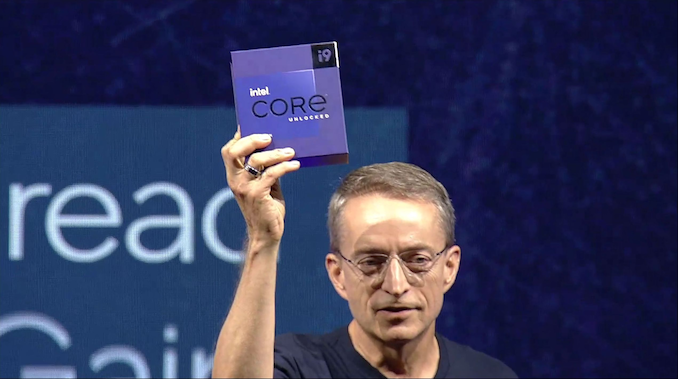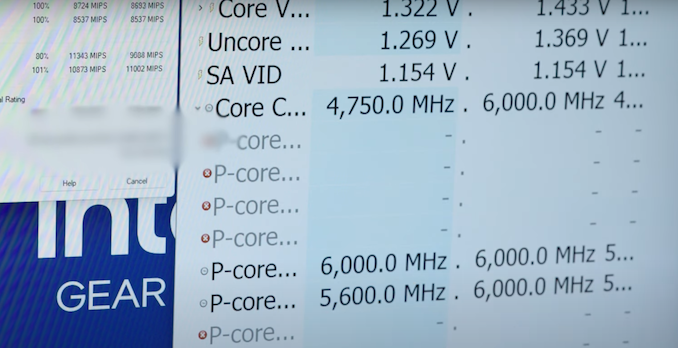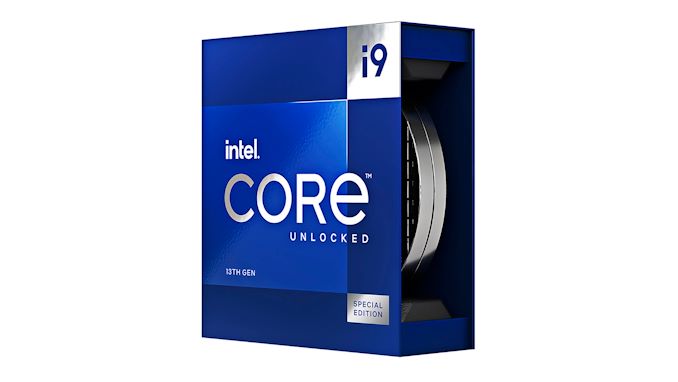Intel Unveils Core i9-13900KS: Raptor Lake Spreads Its Wings to 6.0 GHz
by Gavin Bonshor on January 12, 2023 9:00 AM EST
Initially teased by Intel CEO Pat Gelsinger during their Innovation 2022 opening keynote, Intel has unveiled its highly anticipated 6 GHz out-of-the-box processor, the Core i9-13900KS. The Core i9-13900KS is a special, highly clocked bin of the regular i9-13900K, offering the same 24-core (8P+16E) hybrid architecture, but with an impressive P-core maximum turbo clockspeed of up to 6 GHz.
Based on Intel's existing Raptor Lake-S desktop silicon, Intel claims that the Core i9-13900KS is the first desktop processor to reach 6 GHz out of the box without overclocking. With normal chips hitting up to 5.8GHz, the i9-13900KS is an even more extreme bin of that silicon, with Intel identifying chips that can run even harder to make it to 6 GHz. The trade-off for this extra burst of performance is that the power consumption of the chip is even higher than Intel's usual high-end desktop parts, with an official TDP of 150 Watts, and an "extreme" power profile that goes as high as 320 Watts under load.
Meanwhile, unlike most Intel CPU launches, the company is wasting no time on bringing their new special edition chip to market: the $699 CPU is available immediately.
Intel Core i9-13900KS: 6 GHz P-Core Turbo For $699
The Core i9-13900KS has been a long-awaited entrant to Intel's Raptor Lake-S for desktop family, with previous hints from Intel during their Innovation 2022 keynote that a 6 GHz out-of-the-box processor was on the horizon for this generation. As Intel likes to proclaim, the company considers the Core i9-13900KS to be a significant milestone for desktop PCs, thanks to its 6 GHz out-of-the-box P-Core turbo frequency. This makes it one of the fastest desktop x86 processors ever released, at least from the perspective of users who won't need to overclock anything to attain these ridiculous core frequencies.
This screenshot is taken directly from Intel's Core i9-13900KS promotional video
From Intel's sneak peek video on YouTube which was published on January 10th, the Core i9-13900KS looks to have reached 6 GHz on two of the eight performance (P) cores, with a clock speed of up to 5.6 GHz on the remaining six cores, which is very impressive, even for the already-capable Raptor Lake silicon. Intel hit 5 GHz on a shipping consumer CPU just a bit under three and a half years ago with the Core i9-9900KS, so this latest push to 6 GHz has come relatively quickly compared to the overall relaxed pace the x86 CPU frequencies have been moving at over the last decade or so.
Like its predecessor KS parts, the i9-13900KS is a special bin of Intel's existing silicon. Judging from end-user reports of overclocking the normal Core i9-13900K, we're left with the impression that very few of those chips could hit 6 GHz with ambient air cooling. So the i9-13900KS appears to be a very thin bin, though unlike the i9-12900KS launch, we haven't heard any official statistics from Intel this time around.
Of course, with even higher clockspeeds pushing the chip even farther away from the sweet spot on the voltage-frequency curve, the power consumption of this special edition chip has also gone up. The base TDP (as defined by Intel) is now 150 Watts, up from 125 W for the regular i9-13900K.
More interesting are the PL1 and PL2 power limits. For their latest chief chip, Intel has actually created two official power profiles, which is something they've never done before. The "base" profile sees both PL1 and PL2 set at 253 Watts; this is the same PL2 (turbo limit) as the i9-13900K, but PL1, the long-term expected steady state power consumption of a processor, his been boosted significantly from 125 W to the same 253 W value. PL1 is normally synonymous with a chip's official TDP, so I'm not sure the 150 W figure has much relevance here.
And for system builders that truly want to throw energy efficiency into the wind in favor of peak performance, the new "Extreme" power delivery profile further raises both PL1 and PL2 to 320 W, which correlates to an ICCMax current of 400 Amperes. While it (hopefully) shouldn't be necessary for the i9-13900KS to hit 6 GHz on its handful of favored cores, the extra power should come in handy for helping the remaining CPU cores also hold high clockspeeds, especially under heavy multi-threaded workloads.
Intel at this point hasn't specified how the multiple profiles will work (despite chips going on sale today), but between motherboard settings and Intel's XTU utility, one or both will undoubtedly have access. Otherwise, since the new extreme power profile is an official profile, Intel has confirmed that their standard warranty covers this higher powered mode.
Intel's current Intel 13th Gen Core i9 Series stack stands as follows (as of 01/12/23):
| Intel 13th Gen Core i9 Series: Raptor Lake-S (As of 01/12) | ||||||||||
| AnandTech | Cores P+E/T |
P-Core Base |
P-Core Turbo |
E-Core Base |
E-Core Turbo |
L3 Cache (MB) |
IGP | Base W |
Turbo W |
Price ($) |
| i9-13900KS | 8+16/32 | 3200 | 6000 | 2400 | 4300 | 36 | 770 | 150 | 253/320 | $699 |
| i9-13900K | 8+16/32 | 3000 | 5800 | 2200 | 4300 | 36 | 770 | 125 | 253 | $589 |
| i9-13900KF | 8+16/32 | 3300 | 5800 | 2200 | 4300 | 36 | - | 125 | 253 | $564 |
| i9-13900 | 8+16/32 | 2000 | 5600 | 1500 | 4200 | 36 | 770 | 65 | 219 | $549 |
| i9-13900F | 8+16/32 | 2000 | 5600 | 1500 | 4200 | 36 | - | 65 | 219 | $524 |
| i9-13900T | 8+16/32 | 1100 | 5300 | 800 | 3900 | 36 | 770 | 35 | 106 | $549 |
Comparing the Core i9-13900KS special edition processor directly to the regular Core i9-13900K, almost every clockspeed value has been cranked up to some degree. Thanks to the higher TDP, the official base clockspeeds for both the P and E cores are 200MHz higher, bringing them to 3.2 GHz and 2.4 GHz respectively. Meanwhile the highest turbo boost clockspeed on the P cores is now 6 GHz.
Like the basic i9-13900K, it's important to note that this is not an all-core turbo value – that is, not all 8 P cores will hit 6 GHz. As with the 5.8 GHz peak clockspeed on that chip, this is achieved by layering Intel's Thermal Velocity Boost (TVB) technology on top of their Turbo Boost Max 3.0 technology. Which to simplify things, means that the clockspeed is only guaranteed to be available on the chip's favored core pair, and even then only when the processor is running cool enough that there's enough thermal headroom to punch up the final 200MHz to 6 GHz.
Otherwise, the normal all-core turbo limit for the remaining P cores is 5.4 GHz, which means they can top out at 5.6 GHz when TVB is available. Meanwhile the E cores get no such love, and their turbo limit remains at 4.3 GHz, the same as on the regular i9-13900K.
Rounding out the package, the Core i9-13900KS offers the same 36 MB of L3 cache as Intel's other top-tier Raptor Lake desktop chips. And this is a graphics-enabled SKU, so Intel's UHD 770 integrated graphics are available.
Intel hasn't clarified how many Core i9-13900KS parts will be available during the lifecycle of Raptor Lake-S. As we've seen with previous iterations of its KS edition SKUs, there are typically a limited number of processors produced. Though as the high price tag also means that Intel moves relatively few chips overall, this is primarily an opportunity for Intel to show off with one faster chip.
Intel Client Computing Group (CCG) Manager Marcus Kennedy stated that "The Core i9-13900KS continues our 13th Gen Intel Core desktop processor family excellence, showcasing the new performance heights made possible by our performance hybrid architecture". He also said, "Extreme gamers and enthusiasts can now push their everyday performance further than ever before with the first desktop processor in the PC industry to provide 6.0 GHz speeds at stock".
The Intel Core i9-13900KS is available to buy now at PC retailers, with an MSRP of $699. Officially, this is $40 cheaper than the previous Core i9-12900KS, which launched last year at $739. Otherwise, based on current street prices, initial listings have the chip at closer to $729, which is $130 more than the i9-13900K ($599).












100 Comments
View All Comments
Silver5urfer - Friday, January 13, 2023 - link
Everything is 100% correct on dot. You fail to produce what is wrong clown.nandnandnand - Friday, January 13, 2023 - link
I don't think anyone is surprised at the existence of the KS model, just eager to laugh or balk at hot, expensive Intel parts with minimal gains.AMD's X3D is where the action is in 2023. That could be flawed as well if the asymmetric approach isn't handled properly. However, AMD has to rip off that band-aid eventually, since they are likely to pursue hybrid CPUs combining Zen 5 and Zen 4C cores, for example (which would be another discrepancy of cache and clocks, but also IPC).
Silver5urfer - Friday, January 13, 2023 - link
Not that Hybrid again for AMD. I have mentioned countless times. AMD official slides and Financial report slides, both never mentioned that Zen 4C is for consumers. Bergamo is not a consumer product.AM5 does NOT have Hybrid garbage. It does not exist. AMD's future of x86 big little does not make sense. Intel 13900K is the proof that Intel needs the little cores to accelerate MT performance because look at the power and the heat density with just 8P cores. Intel is at limit, that is the reason why they had to go hybrid design.
PLUS Intel does not have MCM expertise, for that reason their SPR XEON 4th gen was delayed by 1.5 years. AMD on the other hand gained that from 2017. Which is why you see MI300 the pinnacle of MCM design.
Again AMD's processor design of Zen uArch is newer. Intel Core is a derivative of Sandy Bridge design of RING bus and they are just using the same fundamental which is why it is called Intel CORE. Intel hired Jim Keller but due to some BS drama inside with high execs and Jim Keller they ruined it and also Intel hired most of the old staff who designed the foundation of Intel Core, Glenn Hinton on a new uArch redesign. Until that happens Intel CORE will not go away and Intel will face Big little BS always also they have that BGA advantage on Big Little junk so they won't stop making them.
Finally AMD hamfisted the X3D processors. It's worthless. I expected X3D to be a refresh not a stupid "GAMING" PR sticker slapped over it. The TDP is reduced, Base clocks neutered (AMD always reigned supreme in this as Intel base is pathetic 3-3.5GHz while AMD Zen 4 is ultra fast 4.7GHz), Boost clocks neutered. Hamfisted the 12C and 16C parts by making it have single CCD V-Cache and depend on Windows scheduling nonsense. Pure garbage vs Intel's Thread Director HW level layer. Finally the worthless 7950X3D won't imprve anything on MT performance as it got regressed. There's no action here.
Which is why Intel also went with RPL-S Refresh because it's pointless to fight Zen 4X3D with 14th gen as it does not have ANYTHING except gaming garbage. And that gives Intel 14th gen / LGA1851 to have 15th gen vs Zen 5 only as AMD does not plan Zen 6 on that AM5 socket at best 5X3D again a stunted CPU refresh for those GAMERS.
corinthos - Sunday, January 22, 2023 - link
so is Intel the way to go for the next few years or so vs AMD AM5 path? i got a 12900K+z690A motherboard at the moment and trying to decide which split in the road to take.Pneumothorax - Tuesday, January 17, 2023 - link
My biggest concern with the 79XXx3d chips is windows 11 scheduler. It’s still having problems even with the 13900K with the 13600K scoring better at times due to less cores. It’s going to be a bigger issue making sure the app goes to the correct CCDachfoo - Thursday, January 12, 2023 - link
Please, please hire an editor, Anandtech. Thankfully the spelling errors aren't common but just general grammar/wording makes many articles unnecessarily hard to read on the first pass.Wereweeb - Thursday, January 12, 2023 - link
Whoever owns Anandtech is letting it die, honest and intelligent articles doesn't make money like clickbait does.krazyfrog - Thursday, January 12, 2023 - link
Regardless, it isn't too much effort for the author to re-read short posts like these for errors or grammar before hitting publish. You don't necessarily need a copy editor for news posts; most large blogs out there don't have one and do just fine.PeachNCream - Thursday, January 12, 2023 - link
The owner is Future plc (https://en.wikipedia.org/wiki/Future_plc) which bought Anandtech's prior owner Purch. Future also owns Tom's Hardware and other various thingies, but I wouldn't call this particular article clickbait.Ryan Smith - Friday, January 13, 2023 - link
Typically I do some level of copy-edit pass on all front-page articles. However due to the timing of the Intel announcement (we only received a short heads-up), I wasn't available to do it ahead of publication for this one.I've since gone back and done a full copy-edit pass.